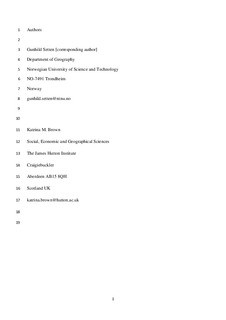| dc.contributor.author | Setten, Gunhild | |
| dc.contributor.author | Brown, Katrina Myrvang | |
| dc.date.accessioned | 2018-12-14T08:46:36Z | |
| dc.date.available | 2018-12-14T08:46:36Z | |
| dc.date.created | 2018-04-25T06:55:21Z | |
| dc.date.issued | 2018 | |
| dc.identifier.citation | Land Use Policy. 2018, 75 549-556. | nb_NO |
| dc.identifier.issn | 0264-8377 | |
| dc.identifier.uri | http://hdl.handle.net/11250/2577672 | |
| dc.description.abstract | Ecosystems approaches, and among them the ecosystem services (ES) framework, are held as promising vehicles for holistic thinking which is usually taken to mean integration of society and nature. The notion of ES is also seen to aid us in saying something about how and what people value in nature. It is hence surprising that among a huge number of scientific works couched in terms in ES, still relatively few explore the explicit engagement of such concepts with stakeholders with respect to empirical issues, including integration. Motivated by a need to empirically test rather than assume the integrative work of ES, we ask: what ways of using the framework as a stakeholder tool are invited, and does integration unfold in practice? Our evidence comes from a study of a group of stakeholders’ perspectives on sustainable management of sheep grazing in low alpine landscapes in the south of Norway. According to the stakeholders, grazing intensity, type and spatiality cannot be understood and arrived at without accounting for how grazing pressure is the result of the co-production of nature and society. By way of four empirical examples, we demonstrate 1) the integrative agency ES can have, 2) how ES can work to integrate despite the framework, 3) how ES can work against integration, and 4) the implicit agency of ES for the co-production of sustainability and grazing pressures. The study demonstrates that there are particular weaknesses in the concept as an integrative device regarding the invisibility of human co-agency. Furthermore, the precise methodological framing of the research is found to be crucial for whether and how human co-agency is made visible through the framework, and thus how ES works as an integrative framework. | nb_NO |
| dc.language.iso | eng | nb_NO |
| dc.publisher | Elsevier | nb_NO |
| dc.rights | Attribution-NonCommercial-NoDerivatives 4.0 Internasjonal | * |
| dc.rights.uri | http://creativecommons.org/licenses/by-nc-nd/4.0/deed.no | * |
| dc.title | Ecosystem services as an integrative framework: what is the potential? | nb_NO |
| dc.type | Journal article | nb_NO |
| dc.type | Peer reviewed | nb_NO |
| dc.description.version | acceptedVersion | nb_NO |
| dc.source.pagenumber | 549-556 | nb_NO |
| dc.source.volume | 75 | nb_NO |
| dc.source.journal | Land Use Policy | nb_NO |
| dc.identifier.doi | 10.1016/j.landusepol.2018.04.023 | |
| dc.identifier.cristin | 1581450 | |
| dc.relation.project | Norges forskningsråd: 212897/E40 | nb_NO |
| dc.description.localcode | © 2018. This is the authors’ accepted and refereed manuscript to the article. Locked until 24.4.2021 due to copyright restrictions. This manuscript version is made available under the CC-BY-NC-ND 4.0 license http://creativecommons.org/licenses/by-nc-nd/4.0/ | nb_NO |
| cristin.unitcode | 194,67,10,0 | |
| cristin.unitname | Institutt for geografi | |
| cristin.ispublished | true | |
| cristin.fulltext | postprint | |
| cristin.qualitycode | 1 | |

